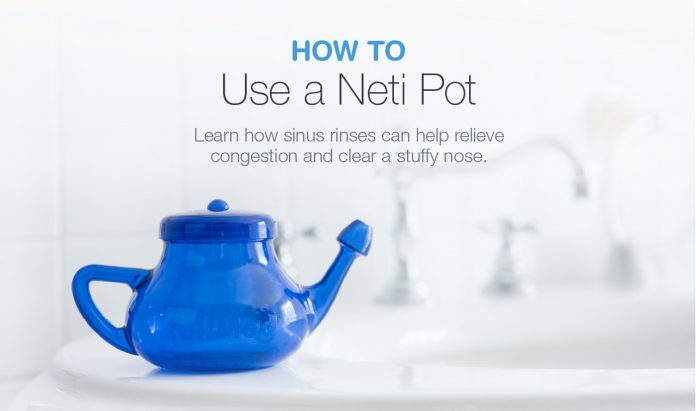Neti Pot corrects how to use if you have experienced nasal congestion, you know what discomfort is felt when breathing during it.
The main cause of nasal congestion is inflammation of the blood vessels of the nose, which is caused by colds, flu, allergies, and sinus infections. Read this article to learn how to use Neti Pot correctly.
After reading this informative article, you can perform Neti for nasal irrigation to flush out the excess mucus and debris from the nose & sinuses. Although this technique of nasal irrigation in Yoga was practiced as a part of Shatakarma (6 purification techniques) since ancient times.
First of all, a neti pot is a hygienic tool that doesn’t need any additional materials to use and is simple to use. Use a typical aqueous solution of salt to wash your nose (preferably sea salt). Regular neti-pot users report feeling lighter and cleaner in their noses. Tonsillitis, chronic sinusitis, and other illnesses of the upper respiratory tract can all be treated using sea salt washing techniques.
Remember taking a bath in the sea? You must have experienced the restorative powers of the ocean more than once. Using Neti-sweat, you may simulate “diving” in the ocean at home by directly irrigating the nasal mucosa with seawater.
What Is Sinusitis and How Does It Happen?
When too much mucus accumulates in the passages behind your face, sinusitis, or sinus irritation, frequently results. When severe, this can result in bacterial infections by causing swelling or inflammation in one or more of these cavities. (1,2) In some people, especially those who have allergies or asthma, this recurs frequently, causing symptoms such as headache, tiredness, poor postnasal drip, and persistent pressure around the nose. (1)
Medication, such as allergy medications or mucus-thinning medications, can be used to treat or prevent sinusitis brought on by allergies. Some patients who are prone to repeated sinus infections may require surgery with an ear, nose, and throat specialist to change the structure of their noses to enable sinus drainage. (1)
Sinus irrigation can be helpful whether or not you take medications or undergo this procedure.
What Is a Neti Pot?
A Neti Pot is a gadget shaped like a teapot that we use to administer the lukewarm saline solution. It has two spherical openings, with the higher, larger opening serving as the fluid’s entrance and the lower opening serving as its exit.
A Neti Pot’s spout end is positioned at one nostril, and gravity causes the saline solution to release naturally from the other nostril. Usually, there is a handle to lift it. This has a look that is similar to Ginni’s lamp.
Nasal irrigation has been done using a Neti Pot. It has been in use for a very long period. The sinus chambers and nasal passages can both be cleaned with a neti pot. Non-obstructed breathing is restored as a result.
Different Types of Neti Pot
Based on the material of the pot, Neti Pot has different types.
1. Plastic Neti Pots
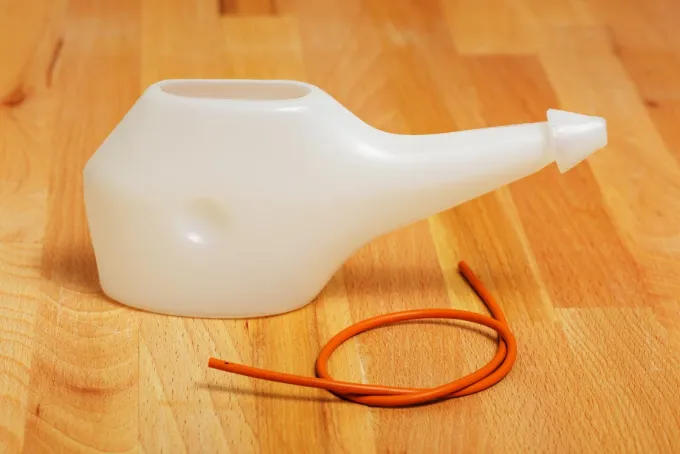
The plastic Neti Pot is lightweight, so pouring the liquid down the nostril is not taxing on the hand. They are also simple to transport from one location to another.
Who can use the plastic Neti Pot?
- Those who are habitual in using light objects.
- People with traveling schedules.
Problems with Plastic Neti Pot
- Some manufacturers are using Grade 3 (PVC) plastics in the production of plastic Neti Pots. Grade 3 (PVC) plastic can cause cancer [efn_note] Common Carcinogens You Should Know https://www.webmd.com/cancer/know-common-carcinogens [/efn_note] in humans.
- It is difficult to feel the exact temperature of the water within the Neti Pot when it is made of plastic.
- Finally, as plastic material generates an unpleasant odor over time, it is not a wise choice for long-term use.
2. Ceramic Neti Pots
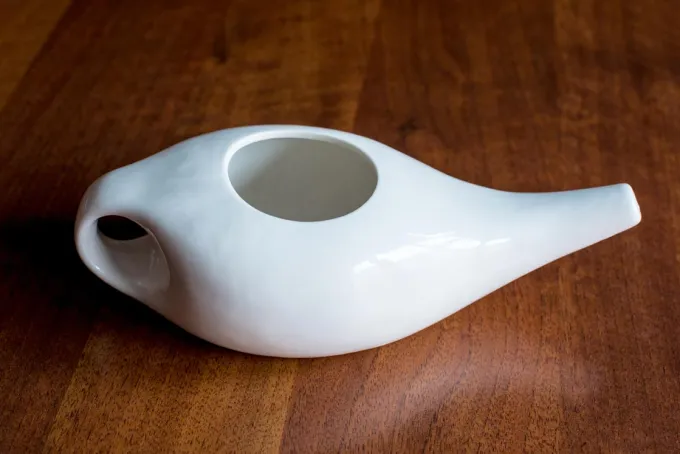
Ceramic Neti Pots are glossy in appearance and made of inorganic particles. They are resilient and heat-resistant, which helps to keep the fluid at a mild temperature. However, in the end, it aids in maintaining body homeostasis (constant body temperature).
Who can use the ceramic Neti Pot?
- Individuals with disturbed homeostasis.
- Those who are fond of ceramic objects.
Problems with Ceramic Neti Pot
Ceramic material’s fragility is one of the apparent reasons why people do not prefer utilizing ceramic Neti Pots. Inappropriate handling can cause it to shatter easily.
Due to a lack of a proper cone tip, a beginner may experience difficulties inserting the spout end of ceramic Neti Pots into their noses.
3. Copper Neti Pots
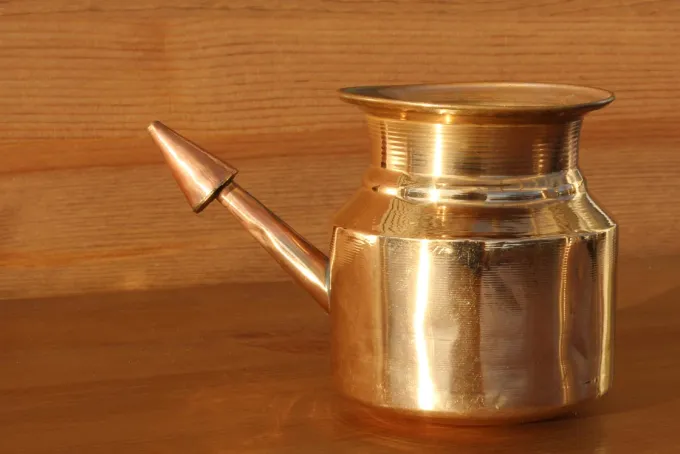
Maintaining fluid in the copper vessel is advantageous, according to Ayurveda. The fluids are sterilized by the copper Neti Pot’s antibacterial qualities. It also keeps the pH of the sinuses and nasal passages stable. So using a copper Neti Pot is by far the best option.
- Patient with imbalanced pH.
- People are prone to minor infections.
- Those who are allergic.
Problems with Copper Neti Pot
However, copper Neti Pot is a great choice one can, still, it has the following demerits:
- Copper Neti pots are quite expensive compared to other types.
- Does copper material get tarnished when it comes in contact with the air [efn_note] What Causes Copper to Tarnish? https://sciencing.com/causes-copper-tarnish-13011.html [/efn_note]. So after using it a few times, it demands proper rinsing.
Benefits of Neti Pot
If you want to clear up your stuffy nose, the Neti Pot is a fantastic tool. Additionally, nasal irrigation has many health advantages, including the following:
1. Relieves Rhinosinusitis
Rhinosinusitis is the condition of inflamed sinus cavities, which is caused by the infection of pathogens. The condition is followed by pain in the facial, nasal, and forehead areas.
Nasal irrigation helps in clearing the dust, pathogens, and excess mucus from the blocked sinuses, which ultimately relieves its symptoms.
2. Clears Nasal Cavities
Alternatively, the thickened mucous layer can be removed by pouring saline solution through each nostril. Additionally, it clears the nasal tube of contaminants and dust that has been suspended over the nasal hairs. The nasal passageway is made transparent.
3. Improves Oxygen Intake
Coughing and unwanted foreign objects reduce air volume per inhalation, which has an impact on the delivery of oxygen. The Neti Pot helps remove all obstruction-causing substances from nasal discharge by irrigating the nasal passages.
4. Safe During Pregnancy
Mayo Clinic [efn_note] Is it safe to take Claritin or other allergy medications during pregnancy? https://www.mayoclinic.org/ [/efn_note] recommended the use of a neti pot during pregnancy as an alternative to reduce the use of allergy medications. This practice relieves nasal and eye symptoms of seasonal or perennial allergic rhinitis.
5. Relieves Snoring
The snoring cause of congested nose [efn_note] Chronic Nasal Congestion at Night Is a Risk Factor for Snoring https://jamanetwork.com/ [/efn_note] is a common problem in people. Nasal irrigation relieves the symptoms of snoring by opening nasal cavities.
6. Sharpens The Vision
When taking special reference to Jala Neti, can improve one’s vision. A review study [efn_note] on therapeutic effects of Neti Kriya https://www.sciencedirect.com/science/article/pii/S0975947617306216 [/efn_note] on the therapeutic effects of Neti Kriya has proved nasal irrigation is helpful in vision improving, eye pain, eye strain, watering, and heaviness of eye.
Nasal Irrigation Using Neti Pot – Ingredients
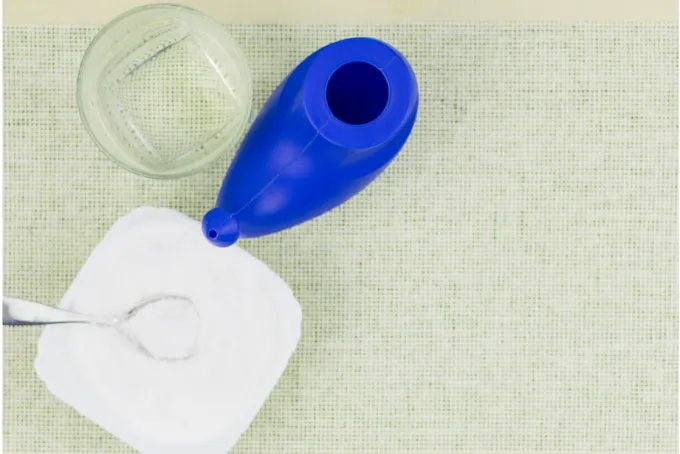
In order to utilize a Neti Pot for nasal irrigation, a solution must first be made. Two to three ingredients are combined to create a solution that can be used in a Neti Pot.
However each of the three ingredients has a distinct purpose and set of results. These are what they are:
1. Salt: A Friend of the Mucous Membrane
The salt content of the saline solution is comparable to that of tears and other bodily fluids. It aids in calming the nose passage’s mucous membrane.
Using high-quality salt, particularly “Neti salt” or “non-iodized salts,” is beneficial. It does not, however, irritate the mucous lining, which is a typical sign of table salt or other contaminated salt sources.
2. Baking Soda: Moisturizing Agent
Saline irrigation on a regular basis may aggravate the nose’s mucous membrane. Additionally, it interferes with the sinuses’ and nasal passages’ natural environments.
In order to assist the nasal lining to regain its moisture, baking soda is added to the saline solution. It also aids in moistening the mucous membrane’s thick, rigid exterior.
3. Water
Water is the basic ingredient of the solution. There is the certainty of getting infected by considering an unhygienic water source. So, selecting pure water is a preventive measure against infection.
To ensure water quality for nasal rinsing, the CDC suggested [efn_note] Treating Water Used for Nasal Rinsing
https://www.cdc.gov/ [/efn_note]:
- Boil water for 3 to 5 minutes (longer at higher altitudes) then leave it cool
- Use water from stores that contain labels of distilled or sterile water
- If boiled or sterile water is not available, use a filter that designed to remove common germs
- If all the above ways are not available, the CDC has mentioned a way to disinfect water to make it safe from Naegleria (brain-eating amoeba).
Making Neti Solution for Nasal Irrigation
The saline solution comes first before using a Neti Pot to flush out the nasal passages. Follow these instructions to create your own Neti solution at home:
- Before making the solution, gather a container, water, non-iodized salt, and baking soda close at hand.
- Put 250 ccs of distilled or sterilized water in the container (tap water is only considered after well boiling).
- Mix the solution after adding 1/2 a spoonful of non-iodized salt and 1/2 a spoonful of baking soda.
- To achieve homogeneity, thoroughly stir the solution in the container.
And, this is our saline solution ready to use.
Easy Steps to Use Neti Pot

After preparing a saline solution as described above, proceed to your sink and follow the instructions below.
Step 1: Handling Over the Sink
- Pour the saline solution from the container into the dry, clean Neti Pot that you are holding.
- Go to the sink and squat down there.
- Turn your head slightly to one side at a 45-degree angle (Left or right, you can start from either side.).
- To keep water from getting in your mouth and throat, tuck your chin.
- Your chin and forehead ought to be parallel.
Step-2 Pouring Water & Breathing Through Mouth
- Lift the Neti Pot and place the spout inside the nose closest to the top (say right side nostril).
- By inclining the Neti Pot more, you can pour the saline solution into the nostril. Simply extend the elbow of your hand to enhance inclination.
- The solution must flow through the nostrils while breathing must be done through the mouth.
- Till it runs out, keep the Neti Pot’s spout affixed to your nostrils.
Repeat the same steps with the other nostril once you’ve finished with one side.
Step-3 Mucous & Solution Discharge
- Remove the Neti Pot slowly after finishing the procedure in both nostrils.
- Remove all of the solution and mucus that is still in your throat and nose.
- Stand tall and with your head held high. With a tissue, clean your mouth and nose.
- By taking a few breaths in and out, you can clear your nasal tube.
Points to Check
- Avoid any blockages in the Neti Pot before pouring the solution into it.
- Make sure water is sterilized or boiled in tap water for the Neti Pot.
- The saline solution should be lukewarm neither too cold nor too hot.
- Clean the Neti Pot with the anti-bacterial soap after use & keep it dry.
Don’t Use Neti Pot When
1. Nosebleeds (Epistaxis) or Nasal Irritation
Due to the bunch of capillaries in the nose area, it is susceptible to suffering nosebleeds [efn_note] Nosebleed (Epistaxis) https://my.clevelandclinic.org/health/diseases/13464-nosebleed-epistaxis [/efn_note].
However, such conditions drastically increase the chances of rupturing capillaries. The use of Neti Pot irrigation could worsen the condition of the patient. So, avoid nasal irrigation in nosebleeds.
2. Headache
The occurrence of a headache might happen for any reason. Nasal irrigation during a headache may cause a loss of focus necessary for mouth breathing, which may result in a choking neck.
3. Cough & Cold
When dealing with a cold, frequent sneezing could be dangerous if nasal irrigation is used. This can cause saline fluid to enter the windpipe, which might temporarily stop breathing. It is therefore advised to stay away from it in that circumstance.
















